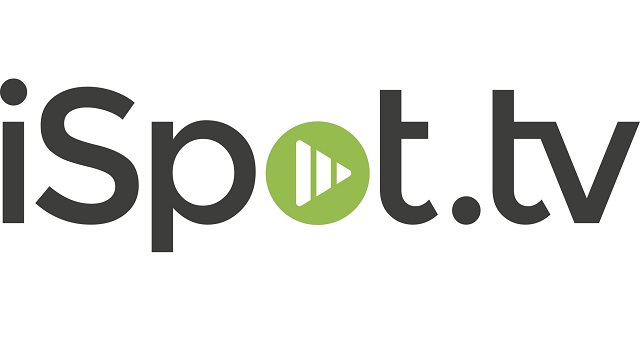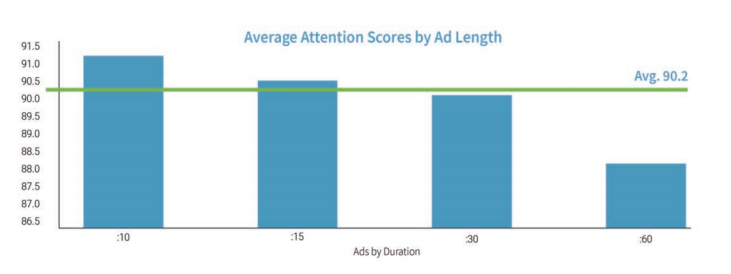Short Commercials Get More Attention: iSpot

Advertising analytics company iSpot.TV said that when it comes to grabbing viewer attention, shorter commercials are better.
The recent introduction and popularization of six-second commercials have led to a lot of discussion about which commercials command attention and deliver a sales message. Advertisers also are looking for data on how best to mix commercials of different lengths in order to create the most compelling campaigns.
In a new report, iSpot says the results of its research couldn’t be clearer about the attention short ads generate.
On average, all of the commercials of all lengths it studies drew an average attention score of 90.2, with most ads falling within a range of 75 and 98, with a few points being a significant difference
iSpot found that in general 10-second commercials performed above the average, while 60-second ads were below average.
The 10-second ads scored the highest attention scores, followed by 15 second spot, 30-second spots and 60-second spots, with the average score for a 10-second spot 4% higher than the average score for a 60-second ads.

There were some exceptions to the rule. iSpot found that 60-second commercials for advertisers in the automotive, travel and entertainment categories produced exceptional results, generating higher attention scores than ads of shorter lengths.
The smarter way to stay on top of broadcasting and cable industry. Sign up below
“These segments may be garnering more attention with longer ads because they tend to put a great deal of emphasis on production quality, beautiful product footage, celebrities, or exciting, fast-paced action,” the iSpot report said.
Conversely, advertisers in categories that scored the lowest attention scores should probably use fewer 60-second commercials, iSpot said in its report.
The lowest-scoring 60-second spots came from the food and beverage, electronics and communications and insurance categories.
“If it’s necessary to use 60-second spots, consider a creative plan that quickly switches to 30-, 15- or 10-second cut-downs of the longer versions,” the report said.
iSpot found that three key factors impact audience attention for commercials.

The first is the ad creative.
“Viewers are less likely to interrupt commercials that are fresh and engaging. Attention Analytics help marketers understand the degree of their ad’s allure. Although the length of the ad plays a significant role in its ability to grab and hold viewer attention, the newness, story and creative style also carry a lot of weight,” the report said.
The show is also a key factor.
“Audience attention can also vary depending on the content it’s associated with. The TV series, show genre, network and day part all play a role in whether the audience pays attention to a particular commercial when it airs. The ad’s position within a show’s ad break can be a factor, too,” according to the report. The report found that in general, the second ad in a pod and the second-to last in a pod tended to get the highest attention scores.
The third key factor is creative wear.
Creative Wear is a measure of ad exposure and eventual audience fatigue,” the report said. “Viewers tend to pay less attention to commercials after they’ve seen them several times. Wear is trackable and can often have a direct, measurable, causal relationship with Attention Scores. The total number of airings, days from the start of a campaign, airings per channel and airings within a show can contribute significantly to the viewers’ propensity to pay attention to a specific commercial.”
iSpost said its statistical insights are based on a study that examined 37,854 commercials that aired a total of 4.69 million times between fourth quarter of 2017 and January 2018.
iSpot is one of a number of relatively new analytic companies offering networks and advertisers new insights into audience behavior. iSpot uses data from smart TVs to measure what viewers are paying attention to.
“Regardless of whether the viewer watches a live or time shifted program, Attention Analytics provide a foundational measure of ad effectiveness by revealing the degree of which an ad is capturing viewers’ attention,” the company said in its report.
It added that TV advertising is becoming more like digital advertising.
“The ongoing convergence of digital and television advertising presents significant opportunities for TV advertisers to reduce costs and improve results. It may be time to take a more holistic, multi-screen approach to video creative, execution, KPIs (like audience attention) and measurement,” iSpot said.
Jon has been business editor of Broadcasting+Cable since 2010. He focuses on revenue-generating activities, including advertising and distribution, as well as executive intrigue and merger and acquisition activity. Just about any story is fair game, if a dollar sign can make its way into the article. Before B+C, Jon covered the industry for TVWeek, Cable World, Electronic Media, Advertising Age and The New York Post. A native New Yorker, Jon is hiding in plain sight in the suburbs of Chicago.

